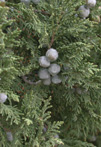

Cypress, Cupressus sempervirens, showing the distinctive fleshy cones of this genus.
THE WOODS USED IN BUILDING Solomon’s temple have long posed a difficulty for Bible students. The beloved King James Version refers to fir and the New International Version refers to pine, when describing the trees that Hiram, King of Tyre, contracted to send to Solomon for the edifice. Hiram notes that he will bring these timbers from Lebanon: “Your servants will bring these down from Lebanon to the sea, and I shall have them towed by sea to any place you name” (I Kings 5:9, NJB), strongly implying that the trees were found on that mountain range. Further evidence for the montane habitat of these trees is this passage: “The glory of Lebanon will come to you, the pine, the fir and the cypress together, to adorn the place of my sanctuary; and I will glorify the place of my feet” (Isaiah 60:13, NIV). What are these trees?
Relatively few trees are native to the Middle East. So it is confusing what the trees in these verses might be and how certain translators have come up with pine, fir, and cypress. (Translation of the tree cedar of Lebanon poses no problem.) The two most prevalent pines in the region are Pinus halepensis, Aleppo pine; and P. brutia, Calabrian pine. The only true fir that is found in the Levant is Abies cilicica (Cilician fir). The third tree that is referred to in several translations, from the Hebrew, berosh, is cypress, Cupressus sempervirens, often translated as pine or fir. To establish which trees are being discussed, we must consider both the linguistic and ecologic factors.

This plant is the fastigate (narrow) form of Cupressus sempervirens in the mountains near the Saladin Citadel in northern Syria, widely planted since Roman times. The female cones are evident; they can remain on the tree for many years and may be an adaptation to a fire-based ecology. The tree compensates for a lack of fire by producing some cones that can open without heat.

Juniper, Juniperus oxycedrus, on Mount Lebanon. Courtesy Houssam Shaiban.
In terms of habitat, the pines and the cypress are not found at higher altitudes. The cilician fir is a component of cedar forests but is found only in the northern part of the Lebanon Range. It is possible that Hiram’s men cut those trees and brought them south to Tyre. But unless the wood had considerable value in a specialty application, this seems unlikely. The remaining tree, cypress, is found extensively throughout the Middle East and is well represented in archaeological finds in Egypt (Gale et al. 2000).
Like the cedar of Lebanon, cypress is a conifer—a cone-bearing tree with hard, durable wood. Its leaves are different from pine and cedar: they are tiny and scale-like. The female cones are round and about the size of a walnut.
Most of the cypress trees I have seen in the Middle East are narrow in form (fastigate), with erect branches usually close to the ground. Because of this growth habit, its attractive green color, and its ease of culture, cypress is a popular tree for planting along roads, in parks, and at homesites. I have seen Byzantine mosaics in Medaba, Jordan, that included this tree form, indicating that this fastigate tree was known to the people of Bible times. Farjon (2005) points out, however, that the abundance of the fastigate form may be an artifact of widespread planting of that tree since Roman times and that natural forests of cypress generally had spreading crowns. Seeds from a single cypress might include both open-crown and fastigate forms.
Cypress wood, which is strong and durable, was highly valued by ancients, especially for monumental doors and statues (Meiggs 1982). Cypress was counted among valuable trees as evidenced in the Bible, where cypress (berosh in Hebew) is linked with cedar and oak: “Open your doors, Lebanon, so that fire may devour your cedar forests. Weep, you cypress trees, for all the ruined cedars; the most majestic ones have fallen” (Zechariah 11:1–2a, NIV). Therefore, while it is not certain that cypress was used in Solomon’s temple, it is a likely candidate, based on uses of cypress in other ancient monumental buildings. “Gopher wood” is mentioned in regard to Noah’s ark: “Make thee an ark of gopher wood; rooms shalt thou make in the ark, and shalt pitch it within and without with pitch” (Genesis 6:14, KJV). Although gopher wood is a mystery, several authors have suggested that it is cypress (NIV).
Another group of trees is sometimes conflated with berosh, the junipers (genus Juniperus). Juniper is represented in the Levant by three or four species that can reach a size suitable for timber. Juniperus oxycedrus and J. excelsa grow at higher elevations (along with the less frequent J. drupacea), while J. phoenicea is common in drier regions. Juniperus phoenicea has been found in archaeological sites in southern Israel (Liphschitz et al. 1981).
Cypress, like cedar of Lebanon, has inspired numerous, though misapplied, common names for other plants. It was one of the most important and durable timber trees in the ancient eastern (Mediterranean) world.